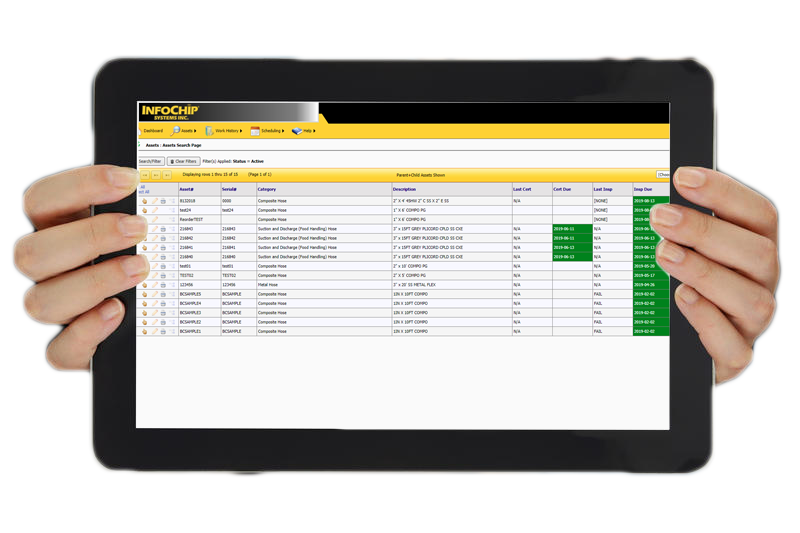S stands for SIZE; I.D. and length; any O.D. constraints overall length should be specified to include fittings tolerances need to be specified if special requirements exist.
- I.D., O.D. and overall length of the assembly
To determine the replacement hose I.D., read the layline printing on the side of the original hose. If the original hose layline is painted over or worn off, the original hose must be cut and inside diameter measured for size. - The inside diameter of the hose must be adequate to keep pressure loss to a minimum, maintain adequate flow, and avoid damage to the hose due to heat generation or excessive turbulence.
- Length Tolerances – the OAL of an assembly shall be as requested by the customer with acceptable tolerances as agreed between the customer and provider. Unless otherwise specified, the tolerances shall be as defined in the following table.
| Hose Diameter | O.A.L. 0" thru <8" | O.A.L. 8" thru <18" | O.A.L. 18" thru <3' | O.A.L. 3' thru < 6' | O.A.L. 6' < 12' | O.A.L. > or equal to 12' |
|---|---|---|---|---|---|---|
| Less than 1" | +/- 1/4" | +/- 5/16" | +/- 3/8" | +/- 1/2" | +/- 1" | +/- 1% |
| 1" through 4" | +/- 3/8" | +/- 1/2" | +/- 5/8" | +/- 3/4" | +/- 1 3/4" | +/- 1.5% |
| 4" through 12" | + 3%-1.5% | + 3%-1/5% | +3% -1.5% | +3%-1.5% | +3%-1.5% | +3%-1.5% |
Flow Rate / Fluid Velocity – The flow rate of the system in conjunction with the inside diameter of the hose will dictate the fluid velocity through the hose. Please consult your hose supplier for specific recommended velocity ranges. Please note that suction line recommendations are different than pressure lines.
- Are there factors such as heat sources in the environment in which the hose will be used?
- Continuous (average) and minimum and maximum temperatures have to be specified for both the environment and material conveyed
- Note if flame resistance or flammability will be an issue
- Sub-zero exposure
- Care must be taken when routing near hot manifolds and in extreme cases a heat shield may be advisable.
- Other things to consider: maximum intermittent ambient temperature, fluid temperature, ambient temperature and maximum temperature.
- Configuration/routing (add a sketch or drawing if applicable)
- Is the hose hanging, laying horizontally, supported, unsupported (orientation and aspect of the hose)
- What else is attached to the hose, any external load on the hose
- Bend radius requirements, flexibility
- Elongation considerations with working pressure
- Quantify anticipated movement and geometry of use requirements
- Intermittant or continuous service
- Indoor or outdoor use
- Unusual mechanical loads
- Excessive abrasion
- Electrical conductivity requirements
- Equipment type
- External Conditions — abrasion, oil (specify type), solvents (specify type), acid (specify type) and concentration), ozone, salt water
- Hose now in use
- Type of hose
- Service life being obtained and description of failure or source of customer dissatisfaction
- Strength and frequency of impulsing or pressure spikes
- Non-flexing applications (static), flexing applications (dynamic)
- Vacuum requirements
- Also can refer to “ALLOY” for metal hose
- Are there special requirements for this hose tube?
- Any special specifications (or agency requirements) that need to be considered (e.g., FDA, API)?
- Will the material be continuously flowing, or sit in the hose for long periods of time (specify)?
- Media velocity, flow rate
- Chemical name/concentration (MSDS)
- Solids, description and size
- Fluid Compatibility – Some applications require specialized oils or chemicals to be conveyed through the system. Hose selection must assure compatibility of the hose tube. In addition to the hose materials, all other components, which make up the hose assembly (hose ends, o-rings, etc…), must also be compatible with fluid being used. Depending on the fluid, your hose supplier may lower the maximum temperature or pressure rating of the assembly.
- When selecting any hose assembly, always consult your hose supplier’s recommendations?
- Also refers to Motion when working with Metal Hose
- System pressure, including pressure spikes. Hose assembly working pressures must be equal to or greater than the system pressure. Pressure spikes greater than the maximum working pressure will shorten hose life and must be taken into consideration.
- Temperature implications
- Vacuum considerations
- Maximum Operating Pressure – This is the maximum pressure that the system should be exposed to in normal operating conditions. For hydraulic hose assemblies, this pressure should be dictated by the relief setting of the system. Both the hose and hose end should not be rated to a pressure less than the maximum operating pressure of the system.
Pressure Spikes – When a hydraulic system is subjected to a large load in a short period of time, the system pressure can overshoot the relief setting and exceed the maximum operating pressure. Frequent pressure spikes can reduce the life of hydraulic hose assemblies. In general, spiral hose constructions are better suited to high impulse applications, which involve flexing and large pressure spikes. However, there are specialized braided hoses available from various manufacturers. Please consult with us if there are multiple constructions which meet your application needs.
E stands for ENDS; style, type, orientation, attachment methods, etc.
Flexible metal hose has a virtually unlimited selection of end fittings that can be attached. End fittings may be male or female pipe threads, unions, flanged, flared tube fittings or other specially designed connectors. End fittings are attached by welding and silver brazing, depending on the type of hose and the alloy.
- Uncoupled or coupled hose
- Specify end style
- Materials and dimensions
- Conductivity requirements
Flexible metal hose is generally used in four types of applications:
- To correct problems of misalignment.
- To provide flexibility in manual handling operations.
- To compensate for constant movement.
- To absorb vibration.
The expected motion of the hose will determine the metal hose product, the assembly configuration and the live length. Care should be taken to choose a hose with appropriate flexibility, an assembly with sufficient live length and motion that will not subject the hose to torque or twist.
D stands for DELIVERY
- Specific to customer requirements
- Testing requirements
- certification requirements (E.g. Coast Guard)
- Any special packaging requirements?
- Any special shipping requirements?
- Tagging requirements
- Also refers to determined overall length when referring to metal hose
Quality Design
The STAMPED acronym stands for the 7 major information areas required to provide a quality hose assembly for the customer, as follows.
High Performance
Your selection of flexible metal hose assembly for particular application should be influenced by six primary considerations
- Media
- Pressure
- Temperature
- Size
- End Fittings
- Expected Motion
Testing Procedures
There are many factors that can affect the service life of flexible metal hose. It is important to evaluate these factors for each hose application. Each individual application can be different than generally outlined applications. Shortened service life and even catastrophic failure can be avoided if the application conditions and individual metal hose assembly are well matched. The typical reasons for hose failure have been provided for design purposes at the link below.
OnGuard Asset Tracker has Maintenance Programs to Improve Hose Safety
Reduce the risk of hose failures through routine hose inspections, testing and certification programs. Our OnGuard™® hose management services include testing, tagging and traceability of your hoses from “cradle to grave”. These proactive programs are managed by our hose experts and keep you running efficiently and safely.


